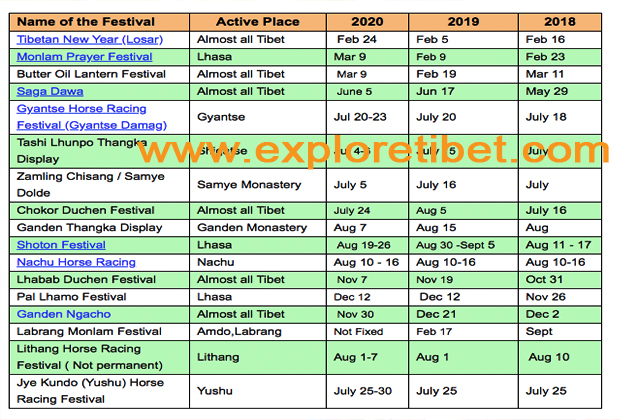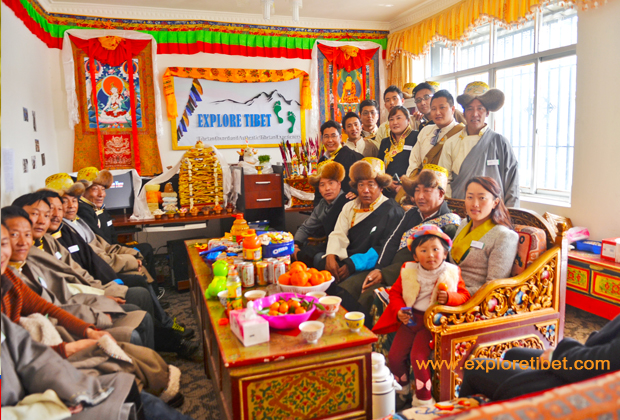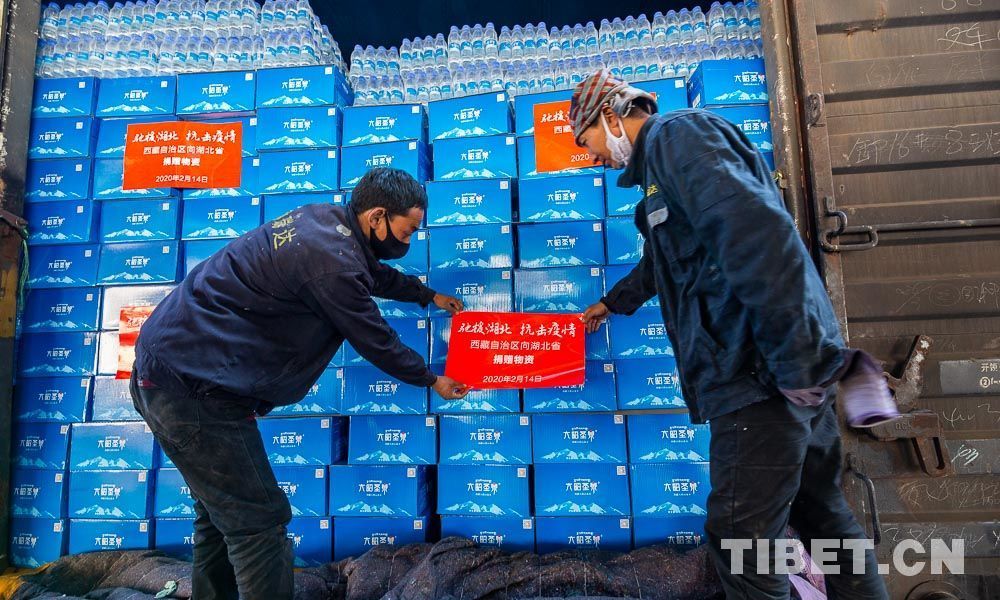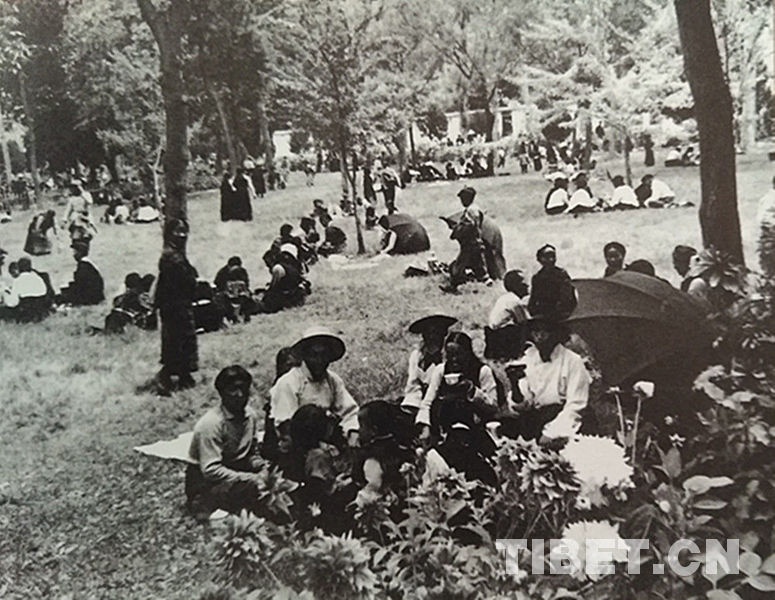Which are the Most Important Tibetan Festivals for a 2020 Tibet tour?
Festivals are not just religious ceremonies in Tibet. They are also social events, where people gather to meet and talk, and even trade and do business in some festivals. And with more than 50 festivals held throughout the year, you can easily book your trip to Tibet to coincide with the festival of your choice to make your Tibet tour more adventurous.

Major Tibetan Festivals in Tibet 2020
Losar - The Tibetan New Year
Held on the first day of the New Year in Tibet and the Tibetan-inhabited areas of Sichuan, Qinghai, and Yunnan provinces, Losar is the traditional festival to celebrate the beginning of a new year in the Tibetan Buddhist calendar. The date of the festival celebrations varies each year in the Gregorian calendar, due to changes in the number of months in the Tibetan calendar to adjust to solar years from a lunar based system. The festival is normally held in either February or March, depending on the calendar.

Tibetan Losar( New Year)
Losar is held all across the plateau, though with some differences in certain areas of Tibet. In Shigatse, the festival is celebrated on the 29th day of the 11th month in the Tibetan calendar, while the “Farmer’s New Year”, or Gtsang New Year, is held on the first day of the 11th month.
The highlights of the festivities include the delicious foods, most primarily the traditional Guthuk, the burning of traditional “sang” to offer blessings to the gods, prayers and worship in the temples, and a lot of singing and dancing. It is also a time to spend with friends and family, and the giving of khada (white scarf) and visiting relatives is commonplace at this time. While the festival does normally last around 15 days, it is the first three days that are the most important.
Saga Dawa Festival
As one of the most important religion-based festivals in the Tibetan Buddhist calendar, the Saga Dawa festival is held in several places across the plateau, but none more so than in Lhasa or at the flagpole of Tarboche, at the foot of the sacred Mount Kailash. Lasting for around a month, the festival celebrates the Birth, Nirvana (enlightenment), and Parinirvana (death) of Buddha Sakyamuni. The festival covers the whole of the fourth month of the Tibetan Buddhist calendar, with the peak being on the 15th day of the 4th month, which is usually around mid-June in the Gregorian calendar.
Tibetans believe that any good deeds and prayers are multiplied a thousand-fold in this month, and people are generally kinder and more giving than usual. Tibetans refrain from killing animals for food, give alms more readily to the monks, and release captive animals back into the wild as ways to gain merits in multiplied quantities. Pilgrims also spend more time taking on the various kora walks around temples and religious or sacred sites, and the kora around the sacred Mount Kailash is one of the most popular.
Tashilhunpo Thangka Festival
When it comes to festivals that include thangka unveilings, the famous Tashilhunpo Thangka Festival is one of the largest on the plateau. Held annually in the Tashilhunpo Monastery in Shigatse on the 14th day of the 6th month in the Tibetan Buddhist calendar (around the end of June to the beginning of July), the festival is one of the most important celebrations in the Buddhist calendar. Also known as the Buddha Exhibition Festival, the main feature of the event is the unveiling of a giant thangka painting on the massive wall above the monastery.
The festival at the Tashilhunpo Monastery lasts for three days, and hosts the unveiling of three different thangka paintings. On the first day the thangka depicts the image of the Buddha Amitabha, which is meant to remind people to cherish their memories of the past and their past lives. The second day hosts the unveiling of the thangka of the Sakyamuni Buddha, which reminds people to pray for a life filled with happiness and joy. And the third day sees the thangka being unveiled as the one that shows the image of the Maitreya Buddha, or Future Buddha, to encourage people to have hope for the future.
Shoton Festival
Once a purely religious ceremony, the Shoton Festival has its origins in the distant past when the Buddhist monks would spend 100 days in seclusion inside the monasteries in fasting and contemplation, and to reduce the chance of killing any living creature, even the smallest ant. When they emerged, they would be presented with milk curds by the local people to show their thanks for the sacrifices of the monks. Over the years, this changed to become yogurt, and the Shoton, or “yogurt banquet” was born.

Shonton Festival-Tibetan Opera Show
These days, the festival is a mix of a yogurt banquet, a Buddha thangka unveiling ceremony, and a Tibetan opera festival. Traditionally, Tibetans go to their local temple and offer yogurt as thanks still, as well as spending time at one of the various festival sites. The most popular is the festival at the Drepung Monastery, where a massive thangka is unveiled on the first day of the festival. The remaining days of the week-long festival are held in the Norbulingka Palace in Lhasa, where you can see Tibetan operas, enjoy the festival’s other events and stalls, and eat lots of yogurt.

Unveiled Thangka at Drepung Monastery
Tsongkhapa Butter Lamp Festival
Held to celebrate the Parinirvana of Je Tsongkhapa, the founder of the Gelug tradition of Tibetan Buddhism, the Tsongkhapa Butter Lamp Festival is held on the 25th day of the 10th month in the Tibetan calendar. Known also as the Ganden Ngachen Chenmo Festival, it is time when butter lanterns adorn the walls, windowsills, and rooftops of monasteries and houses all across Lhasa. On religious altars, in every temple, and in the homes of the Tibetan people, hand-crafted lanterns made from yak butter are lit to commemorate the passing of one of Tibetan Buddhism’s greatest masters.
The lanterns are created a few days before the date of the festival, and monks and lamas in monasteries spend days in icy-cold conditions carving out the butter lanterns to ensure they will not melt. As night falls on the date of the festival, the lamps are lit all over the city, and the bright lights of the flames can be seen for miles. In Tibetan Buddhism, odd numbers are known to be auspicious numbers, so there should always be an odd number of lanterns in the place where they are lit. For the best location for the Ganden Ngachen Chenmo Festival, head for the temple square in front of the Jokhang Temple, where the lamps are lit along the streets and the roofs of the temple to the accompanying sounds of the Suona.
In short, every festival has its own unique way of celebrating and each festival will revile the richness of Tibetan culture and Tibetan Buddhism which had been inherited till today. Thus, it will be a great moment for you to spend your Tibet Tours with any of these festivals and you can write to us at sales@exploretibet.com for detail travel information to Tibet.


